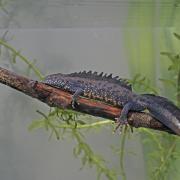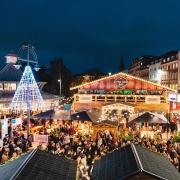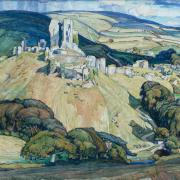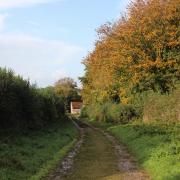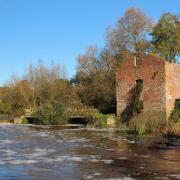The RSPB’s nature reserves in Dorset offer a wonderful alternative to the beach for a family day out in August. At RSPB Arne, there are over eight miles of trails taking you through magnificent ancient woodlands to shoreline, or across heathlands. At this time of the year the latter is a mass of purple due to flowering heathers. Over in Weymouth there are two nature reserves both within walking distance of the railway station and town centre car parks. RSPB Radipole Lake and RSPB Lodmoor are urban oases which offer visitors a marvellous opportunity to see wetland wildlife close-up.
August is a great time to watch dragonflies and damselflies at both RSPB Arne and the Weymouth reserves. Dragonflies first appeared during the Early Jurassic era over 200 million years ago. Known as ‘Dragounfleoge’ in old English, which translates as ‘dragon like flying insects’, they are mesmerising to watch as they flit across lakes and heathland ponds. They can fly at speeds of up to 30 miles per hour making them one of our fastest insects. As a rule, dragonflies are larger and sturdier in appearance than damselflies. Both have two pairs of wings. Dragonflies hold theirs wings away from their body whereas damselflies tend to hold theirs along their body.

All dragonflies (and damselflies) go through three phases - egg, larva or nymph, and adult. In ancient mythology these insects were seen as an emblem of change, most likely due to their ability to go directly from larvae to adulthood without the ‘in between’ pupal stage that butterflies have. The females of these species either lay their eggs directly in the water, on vegetation, or on rotting wood. They can lay hundreds of eggs, some hatch in a few weeks, other species’ eggs may not hatch until the following year.
The eggs hatch into larvae that can remain in this stage for anything from a few months to over five years. The larvae moult several times during this period as they get bigger, shedding their exoskeleton. The nymphs eat snails, tadpoles, other insect larvae, and even small fish. They in turn are potential food for larger fish such as trout.
At the final moult stage, the nymphs leave the relative safety of the water and find suitable vegetation to support them as they change into their adult dragonfly or damselfly form. They push their adult body out of the nymph skin until they have left behind an empty nymph shell known as an exuvia. You can sometimes find these attached to waterside vegetation.

The body of the adult gradually hardens and strengthens, and they hunt for food before returning to water to breed. They are quite vulnerable to attack from predators during this wing hardening phase and birds swoop around the water trying to catch them. At RSPB Arne you might see one of our summer visiting birds of prey, the hobby, hunting for dragonflies and small birds. It’s quite a sight to behold.
Adult dragonflies and damselflies generally only live for a couple of weeks at most. You might have seen these colourful creatures breeding, where their bodies join to form a heart or circular shape as the male transfers the sperm to the female. The female then either lays her eggs in the water or on vegetation growing in it and so the cycle beings again.

At RSPB Radipole Lake you will see many different species of dragonflies, but keep your eyes peeled for one very special one - the Norfolk hawker dragonfly. This is a rare species and is protected under the Wildlife & Countryside Act. For some time, it was only found in Norfolk, but it has now started to spread and there are small populations across the south of England including here in Dorset. It's very striking and so relatively easy to identify - with big green eyes and a tiny yellow triangle near the top of its abdomen.
If you visit RSPB Radipole Lake do pop into our Discovery Centre. From the large picture windows in the café, you can look out across the lake. You can watch the wildlife whilst enjoying tea and cake. Our café is run by SWRAC Specialist Independent College which works with young adults who have additional needs. Through the cafe they offer valuable work experience for their students.
Over at RSPB Arne there are many ponds dotted across the reserve. The appropriately named Dragonfly Pond on the Shipstal Trail is an ideal location to watch the many dragonflies and damselflies flitting around. If you wish, buy a dragonfly guide from the on-site shop to help you identify these fast-moving and colourful flying dragons.
rspb.org.uk/days-out/reserves/arne
rspb.org.uk/days-out/reserves/radipole-lake
rspb.org.uk/days-out/reserves/lodmoor
Bespoke Nature Walks
If you want to learn more about any of the wildlife on the RSPB’s Dorset nature reserves, then book one of our exclusive Hire a Guide experiences. These make a great gift for friends or family who enjoy wildlife. Your exclusive guide takes you and up to three others on an exploratory walk through the reserve. This could be a general nature walk, a birding walk, an historical walk, a reptile themed walk, or a family activity such as a bug hunt or shoreline scavenge. You might even get to peek behind-the-scenes in areas usually closed to the public. Hire A Guide tickets are valid for a year from the purchase date. To book your Hire A Guide experience, please email arne@rspb.org.uk at least four weeks in advance of your requested visit date. Costs: £92 for RSPB members/ £115 for non-members, including reserve entry (both have a £1 booking fee). events.rspb.org.uk/events






